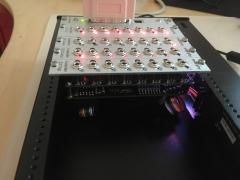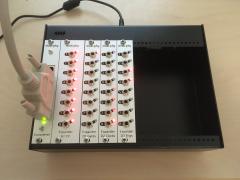-
Posts
15,193 -
Joined
Content Type
Profiles
Forums
Blogs
Gallery
Everything posted by TK.
-
A downstripped MBHP_CORE_STM32F4 module in Eurorack format would be nice-to-have as an alternative solution to the Euroreceiver - maybe with a SCS (6 buttons, encoder, display) - this would allow to run MBCV which gives us a lot of LFOs, Envelopes, sequencers, modulation matrices, etc. Best Regards, Thorsten.
- 135 replies
-
- line driver
- cv/gate
-
(and 2 more)
Tagged with:
-
Modules in 4ms Pod40X case - fortunately fitting w/o modifications :) Best Regards, Thorsten.
- 135 replies
-
- line driver
- cv/gate
-
(and 2 more)
Tagged with:
-
From the album: TK: midiphy Eurorack CV
Eurorack modules in 4ms Pod 40X case, 51mm module depth -
From the album: TK: midiphy Eurorack CV
Eurorack modules in 4ms Pod 40X case, 51mm module depth -
Fortunately no problem to support negative values :) Please try this version: http://www.ucapps.de/mios32/midibox_ng_v1_037_pre5.zip Best Regards, Thorsten.
-
In this particular case you could also "set ^section 2", it should do the same (because ^section 2 follows ^section 1, no jump required) Best Regards, Thorsten.
-
Hi, there is currently no way to declare custom variables, but you can use the storage of any unused event instead. E.g. let's say you don't use LED:1000, then just use it to store your value. Best Regards, Thorsten.
-

Please help me to understand how the NG app works internally
TK. replied to tago's topic in MIDIbox NG
As mentioned by Christian, there was no special reason why assigned DIN and DOUT SR #9 to the DIO function. I thought this might be better in case you would like to add more physical SRs in future, no need to change the IDs again until you reach #9. If you don't like this, you could also use SR #3, but not SR #1 or SR #2, because these positions are already allocated by the scan matrix. Btw.: the most simple way to find out the hw_ids is to enter "set debug on" in the MIOS terminal, then trigger the buttons and observe the debug messages in the terminal (doesn't work with LEDs of course, but if you know the button position, you can easily conclude on the LED position) Best Regards, Thorsten. -
Hi, I'm surprised, all events should listen to incoming MIDI messages, regardless of the bank. Best Regards, Thorsten.
-

Please help me to understand how the NG app works internally
TK. replied to tago's topic in MIDIbox NG
Yes, there is a conflict with the shift register assignments. Try this one: # now enable DIOs (0 = input / 1 = output) DIO port=J5AB emu_din_sr=9 emu_dout_sr=9 output_mask=01010000 # button events (DIN SR1 pins are assigned to hw_id=65/67) EVENT_BUTTON id=65 hw_id=65 type=CC chn=1 cc=16 range=0:127 fwd_id=LED:66 EVENT_BUTTON id=67 hw_id=67 type=CC chn=1 cc=17 range=0:127 fwd_id=LED:68 #EVENT_BUTTON id=65 hw_id=65 type=Meta meta=RunSection:1 button_mode=OnOnly #EVENT_BUTTON id=67 hw_id=67 type=Meta meta=RunSection:2 button_mode=OnOnly # LED events (DOUT SR1 pins are assigned to hw_id=66/68) EVENT_LED id=66 hw_id=66 type=CC chn=1 cc=16 range=0:127 EVENT_LED id=68 hw_id=68 type=CC chn=1 cc=17 range=0:127 Best Regards, Thorsten. -

Please help me to understand how the NG app works internally
TK. replied to tago's topic in MIDIbox NG
Could you please post your complete .NGC and .NGR file? I will check it tomorrow... Best Regards, Thorsten. -

Please help me to understand how the NG app works internally
TK. replied to tago's topic in MIDIbox NG
No, don't worry, outputs are protected against shorts internally. Just tried your configuration, it works after changing fwd_id=LED:3 to fwd_id=LED:2 (we always forward to a hw_id) RESET_HW # J5A PORT SETUP # J5.A0 -> octave up switch # J5.A1 -> octave up LED # J5.A2 -> octave down switch # J5.A3 -> octave down LED # now enable DIOs (0 = input / 1 = output) DIO port=J5AB emu_din_sr=1 emu_dout_sr=1 output_mask=01010000 # button events (DIN SR1 pins are assigned to hw_id=1/3) EVENT_BUTTON id=1 hw_id=1 type=CC chn=1 cc=16 range=0:127 fwd_id=LED:2 EVENT_BUTTON id=2 hw_id=3 type=CC chn=1 cc=17 range=0:127 fwd_id=LED:4 # LED events (DOUT SR1 pins are assigned to hw_id=2/4) EVENT_LED id=3 hw_id=2 type=CC chn=1 cc=16 range=0:127 EVENT_LED id=4 hw_id=4 type=CC chn=1 cc=17 range=0:127 As you can see, I also added "RESET_HW" to ensure that previous settings are undone. The LEDs shouldn't be dimmed. Best Regards, Thorsten. -
Pulse widths up to 10 mS are now supported, could be nice if you could try it out: Best Regards, Thorsten.
-
Based on my experiences with MB808 the trigger width is crucial, therefore I can fully understand Andrews request that a digital option is desired. The "pipeline based approach" is working fine, we can now adjust the width from 0 (=off -> gate function) to 10 mS o DOUT_1MS_TRIGGER in the MBSEQ_HW.V4 file has been replaced by a configurable trigger width which can be adjusted in the CV Configuration Page with GP13 now -> http://www.ucapps.de/mios32/midibox_seq_v4_096_pre7.zip It would be great if everybody could help to test this new firmware version, regardless if the new CV features are used or not (I hope that nothing else is broken!) I would like to create a final v4_096 release, because v4_095 is from last december, and it started to smell! ;-) Best Regards, Thorsten.
-
Update to the 1ms delay: I could "pipeline" the triggers, this way we could get a cheap pulse stretcher. Is there the need for more than 4 mS (= 3 pipeline stages)? Best Regards, Thorsten.
-

Please help me to understand how the NG app works internally
TK. replied to tago's topic in MIDIbox NG
New version can now be found here: http://www.ucapps.de/mios32/midibox_ng_v1_037_pre4.zip It's now possible to mix input and outputs on a single port as shown in this example: https://github.com/midibox/mios32/blob/master/apps/controllers/midibox_ng_v1/cfg/tests/diocfg_3.ngc And J5 is supported as well (called J5AB) - it's even possible to mix digital with analog functions -> https://github.com/midibox/mios32/blob/master/apps/controllers/midibox_ng_v1/cfg/tests/diocfg_4.ngc In your case, please keep the analog pins disabled Best Regards, Thorsten. -
The data update rate is only 35 uS for all 4 modules, so no need to make it more complicated :) That's also the reason why I enabled all 32 channels by default, it doesn't make a big difference. Using a second CS line wouldn't help, because SPI transfer time would have to be consumed anyhow. With channel 9-13 you can route note and velocity value to two CV outs - in this case you need all 32 outputs. But you can also route CCs of a track to the CV outs (starting at CC#16 as far as I remember...) Actually I looked into this, but there is a technical problem. The 64 drum triggers are currently cleared with each SRIO update cycle, this was very pragmatic and effective and especially doesn't consume resources (counters) and CPU time (processing the counters) For individual delays I would have to implement counters for each trigger, and this is very costly. And for a single delay we would potentially run into the problem, that each mS a new trigger could reset the counter, leading to "stretched signals" for all triggers for which the configured time already passed... Best Regards, Thorsten.
-
New major enhancement available for MBSEQ V4+ users - up to 32 CV channels and gates! :-) -> http://www.ucapps.de/mios32/midibox_seq_v4_096_pre6.zip o Only for MBSEQV4+: support for up to 32 CV outputs (and corresponding gates). Means: up to 4 AOUT modules can be chained. Tested with MAX525 (and midiphy Eurorack Expander), but should also work with TLV5630 based AOUT_NG The additional CV outputs can be accessed with MIDI port CV2..4. o AOUT port has been renamed to CV1..CV4 o Utility Page, GP Button #11 now changes to the CV Configuration Page Best Regards, Thorsten.
-
still relevant or just a quick idea? Will lead to some effort at my side... therefore I would only add this if other people find it useful as well Best Regards, Thorsten.
-
I guess that you mean MIDI clock/start/stop (MMC isn't supported) They can already be enabled/disabled for each MIDI port in the BPM menu Best Regards, Thorsten.
-
Fixed in v4_096_pre6
-

Please help me to understand how the NG app works internally
TK. replied to tago's topic in MIDIbox NG
Yes, this will be possible - it's exactly the intention behind NGR to allow users such customizations without touching the application code. Best Regards, Thorsten. -

Please help me to understand how the NG app works internally
TK. replied to tago's topic in MIDIbox NG
Yes, for me it will be straightforward - I'm just a bit worried that than more options I'm adding, than more complicated for others to understand the configuration... ;-) Tomorrow I'm planning a change for CV handling anyhow, if nothing else happens, I will add J5 IOs as well Best Regards, Thorsten. -

Please help me to understand how the NG app works internally
TK. replied to tago's topic in MIDIbox NG
IO Pins are not initialized in your pseudo code. But regardless of this, it will result into the problem that the MBNG application will overwrite IO configurations from different places - and even if we find quick&dirty hacks which avoid such overwrites, you would have to re-do the changes whenever a new firmware version is released. Therefore I recommend to go the common way and to use the existing app like it was intended. Alternatively I could consider to natively support J5 as digital IO in a proper way (which will require changes at many places that I've to work out by myself...) Best Regards, Thorsten.



